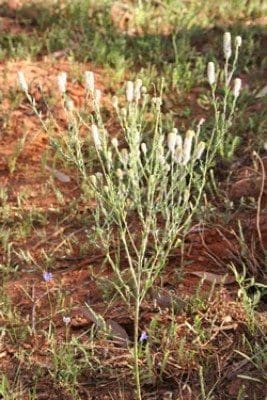Producers are being warned that recent seasonal conditions could lead to growth of the weed Pimelea, which is poisonous to cattle, sheep and horses and is potentially fatal to cattle.
It is most common in south-west Queensland, north-west NSW and northern SA. Pimelea poisoning is also known as St George disease, Marree disease, ‘big-head’ and flaxweed poisoning.
According to retired researcher Richard Silcock, an author of the Queensland Department of Agriculture and Fisheries Guide to Pimelea Poisoning of Cattle, the recent dry summer followed by autumn rainfall and prolonged cloud cover could see Pimelea incidence increase towards the end of this winter.
“Predicting when a large number of seedlings of any of the three poisonous species will establish is difficult. Therefore, field observation by the producer for significant numbers of young seedlings is a key requirement for management,” he said.
Dr Johann Schröder, MLA Project Manager Animal Health and Biosecurity, said while both cattle and sheep suffered intestinal irritation from ingesting Pimelea, the impact on cattle could be dramatic and result in death.
“It is far better to limit animal exposure to Pimelea, than suffer the consequences. There is information available to help producers manage this, including on the MLA website,” he said.
Here are the facts on Pimelea, compiled by Richard Silcock:
- When and where: Pimelea incidence is episodic on a broadacre basis, but in
certain places it can be found in most years – most likely ephemeral lakes, run-on areas and waterways. Germination of seeds seems to require coolish weather and prolonged cloud cover after rains begin. Hence, autumn to spring are the months most likely to see widespread germination. Adequate rain can be as little as 15mm if mild, cloudy weather follows, but may need to be 25mm if sunny weather follows straight after. The seedlings are not particularly ‘tough’ so early deaths can occur if it is dry, competition from other plants is intense or damping-off organisms are active after rain.The poisonous species thrive when there is minimal competition, especially from other winter herbage, and in more open grassy pastures. During and immediately after a drought, Pimelea is more prominent and can grow more profusely. The bind for producers is how much can grazing pressure be lightened off without having a big impact on the economics of the operation.
- Animals at risk: Pimelea is very unpalatable to stock with full bellies. They avoid them and graze surrounding plants, giving the Pimelea a freer rein to grow bigger and set more seed. Animals that have been reared in Pimelea country seem to learn to avoid eating the plants. Animals that are brought into Pimelea country are far more susceptible because they don’t know otherwise. If they have had a long truck journey to get to a new place, their hunger will exacerbate the problem as they eat everything in sight when first let out. The same logic may apply to animals used to one type of country being moved to different country on the same large property.
- Potential outbreaks: The plants are pseudo-annuals and have seasonal flushes. Where animals are regularly exposed to a small amount of Pimelea in an adequate total feed intake they will probably develop a tolerance and retain that for some time. After a run of reasonable or good years, Pimelea will normally be at a low level in paddocks and animals will avoid them. Also the animals, apart from old cows, will not have been exposed to Pimelea poisoning before because they are routinely turned off at three to four years of age. So in the next drought or dry season, Pimelea has a chance to flourish and most stock are ignorant of its poisonous nature when consumed in significant quantities.
- In poor seasons, if Pimelea is present it is very hard for cattle to grab a mouthful of dry pasture without getting a little bit of small Pimelea plants and fluffy seeds. In more extreme situations there is little feed and so even old dead stalks of Pimelea from last year may be eaten and they can still contain some of the toxin.
So after a bad poisoning year, the incidence tends to subside and usually disappears after the drought breaks and better seasons return – until the ‘trigger’ is reset at the start of the next drought year/s awaiting suitable establishment rains to kick off a big population increase and good growing conditions for Pimelea.
- Management tips: Producers who have learned to live with Pimelea work hard to have some paddocks virtually free of Pimelea so that, on the first sign of problems, they can move animals out of poisonous paddocks into clean or hospital paddocks. Alternatively, in mixed operations, producers can move sheep into the paddocks with Pimelea and move the cattle elsewhere or sell them. However, movement must be gentle because the hearts of livestock are under stress from the poison. Anything that gives animals a better diet will help minimise poisoning risk and recovery but that diet must contain plenty of energy and protein. Mineral supplements alone will not usually help and administration of diuretics to valuable breeders is only a stop-gap measure to relieve current physical distress.Pimelea thrives where country is disturbed, independent of the plant competition factor. So graded roadsides, pipelines, firebreaks, blade-ploughed or stick-raked country are ideal sites for Pimelea to flourish. These can’t be completely avoided but managers can watch them relatively easily and take action such as spraying with herbicide or slashing or regrading a roadside, or moving stock away early.
Source: Meat & Livestock Australia.
Contacts for more information:
Dr Mary Fletcher, University of Queensland. E: mary.fletcher@uq.edu.au
Jenny Milson, Longreach office of Queensland Department of Agriculture and Fisheries E:jenny.milson@daf.qld.gov.au
Tim Emery, Roma office of Queensland Department of Agriculture and Fisheries E: timothy.emery@daf.qld.gov.au
Trudie Atkinson, Trangie office of NSW Department of Primary Industries E: trudie.atkinson@dpi.nsw.gov.au

